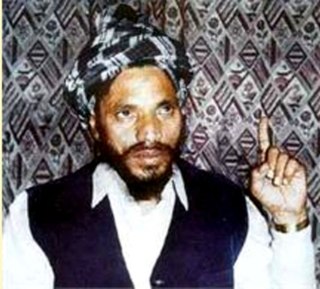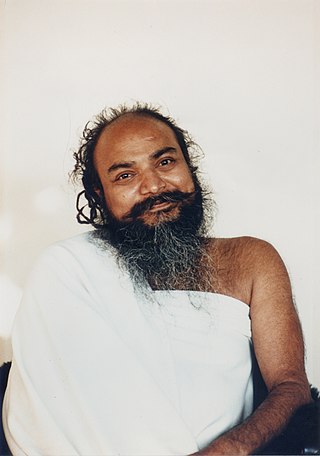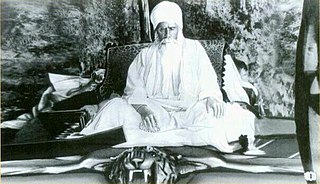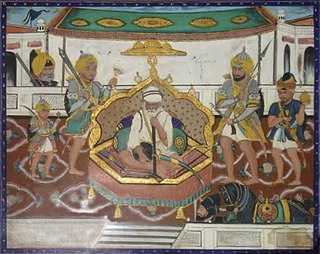Surat Shabd Simran is a type of spiritual meditation in the Sant Mat tradition.

Radha Soami is a spiritual tradition or faith founded by Shiv Dayal Singh in 1861 on Basant Panchami Day in Agra, India.

Shiv Dayal Singh, known by the honorific "Param Purush Puran Dhani Huzur Soami Ji Maharaj" by his disciples and devotees, was an Indian spiritual guru and founder of Radha Soami, a 19th-century spiritual sect.
Jainism (/ˈdʒeɪnɪzəm/), traditionally known as Jain Dharma, is an ancient Indian religion. Jain dharma traces its spiritual ideas and history through a succession of twenty-four leaders or tirthankaras, with the first in current time cycle being Lord Rishabhanatha, whom the Jain tradition holds to have lived millions of years ago, the twenty-third tirthankara Parshvanatha whom historians date to 8th or 7th century BCE, and the 24th tirthankara, Mahāvīra around 500 BCE. Jains believe that Jainism is an eternal dharma with the tirthankaras guiding every cycle of the Jain cosmology.

Piara Singh Bhaniara also known as Baba Bhaniara, was a Dalit religious leader from Punjab, India. He established a breakaway Sikh sect in the 1980s, which was opposed by orthodox Sikhs as insulting to their faith. In 2001, his followers published their own holy text Bhavsagar Granth, and allegedly insulted the Sikh holy book Guru Granth Sahib. This sparked violence against Bhaniara's followers. The Punjab government banned Bhavsagar Granth, and arrested and jailed Bhaniara.
Shri Amrit Nath Ashram is an ashram of the Nath Sampradaya of MannaNathi Panth founded by Shri Amritnathji Maharaj in a small town of Fatehpur in region of Shekhawati which comes in Sikar district of Rajasthan, India. The region of Shekhawati is renowned for its artwork and beautiful havelis. The area is also very rich in wildlife, particularly birds, with different varieties of parrots, peacocks, white eagles, nilkanths and other exotic species.
Ravidassia or the Ravidas Panth is a religion based on the teachings of Guru Ravidas. It was considered a sect within Sikhism until 2009. However, some Ravidassias continue to maintain Sikh religious practices, including the reverence of the Guru Granth Sahib as their focal religious text, wearing Sikh articles of faith (5Ks), and appending Singh or Kaur to their names.

Dera Sacha Sauda is an Indian non-governmental organization described as a "religious cult" and "non-profit social welfare dera" that was established on 29 April 1948 by Mastana Balochistani, an ascetic follower of Baba Sawan Singh, as a centre for religious learning. After Baba Sawan Singh, the movement split into four groups, one of them led by Mastana Balochistani. After the death of Mastana Balochistani, his movement was split into three groups, with Satnam Singh leading the Sirsa group, who selected Gurmeet Ram Rahim to be his successor. Dera Sacha Sauda's main centre is situated in the city of Sirsa in Haryana state, northern India. The organisation has 46 ashrams (divisions) across India and other countries.

Gurmeet Ram Rahim Singh Insan, known also as MSG, is the head of the Indian social group Dera Sacha Sauda (DSS) since 1990. He is a religious leader, social worker, actor, singer, writer, songwriter, director, and composer. In addition to a 2017 rape conviction, he was also convicted of being involved in the murder of journalist Ram Chander Chhatrapati.

Ravidas or Raidas (1267–1335) was an Indian mystic poet-saint of the Bhakti movement during the 15th to 16th century CE. Venerated as a guru in the modern regions of Uttar Pradesh, Bihar, Rajasthan, Gujarat, Maharashtra, Madhya Pradesh, Punjab, and Haryana, he was a poet, social reformer and spiritual figure.

Shri Shivabalayogi Maharaj was a yogi who claimed to have attained self-realization through twelve years of arduous tapas, meditating in samādhi for an average of twenty hours a day.
The Ad-Dharmi is a sect in the state of Punjab, in India and is an alternative term for the Ravidasia religion, meaning Primal Spiritual Path. The term Ad-Dharm came into popular usage in the early part of the 20th century, when many followers of Guru Ravidas converted to Sikhism and were severely discriminated against due to their low caste status. Many of these converts stopped attending Sikh Gurdwaras controlled by Jat Sikhs and built their own shrines upon arrival in the UK, Canada, and Fiji Island.Ad-Dharmis comprise 11.48% of the total of Scheduled Caste communities in Punjab.

In Hinduism, Sikhism, and Sufism a samadhi or samadhi mandir is a temple, shrine, or memorial commemorating the dead, which may or may not contain the body of the deceased. Samadhi sites are often built in this way to honour people regarded as saints or gurus in Hindu religious traditions, wherein such souls are said to have passed into mahāsamādhi, or were already in samadhi at the time of death.
Balwant Singh Nandgarh was an Indian Sikh politician and Jathedar of Takht Sri Damdama Sahib, one of five seats of temporal authority of Sikhism.
The 2015 Guru Granth Sahib desecration refers to a series of desecration incidents of the Sikh Guru Guru Granth Sahib and subsequent protests that took place in Punjab, India in October 2015, although it is known as the 2015 Guru Granth Sahib desecration it started from 2014 and continues till 2021. The first incident of desecration was reported from Bargari, Faridkot district, where 110 torn Angs of the holy Book were found on 12 October. On the early morning hours of 14 October, two Sikhs were peacefully protesting and were shot dead by the police as the protesters were sitting in demonstration.

Sikh sects, denominations, traditions, movements, sub-traditions, also known as sampardai in the Punjabi language, are sub-traditions within Sikhism that believe in different approaches to practicing the religion. All sampradas believe in the One Creator God typically rejecting both idol worship and caste systems. Different interpretations have emerged over time, some of which have a living teacher as the leader. The major historic traditions in Sikhism, states Harjot Oberoi, have included Udasi, Nirmala, Nanakpanthi, Khalsa, Sahajdhari, Namdhari Kuka, Nirankari and Sarvaria.

Sant Baba Nand Singh was a Sikh Saint. He is known as the founder of the Nanaksar Kaleran sampradya of Sikhism.
A dera is a type of socio-religious organization in northern India. Jacob Copeman defines the deras as "monasteries or the extended residential sites of religious leaders; frequently just glossed as sect".

Harmeet Singh also known as PhD or Happy was the 8th chief of Khalistan Liberation Force.

Bhai Maharaj Singh was a prominent Sikh saint-soldier (sant-sipahi) turned revolutionary anti-colonial resistance fighter of the early British colonial establishment in the Punjab. He is also remembered as the first Sikh in Singapore on record, having been exiled there as punishment in the latter part of his life.












